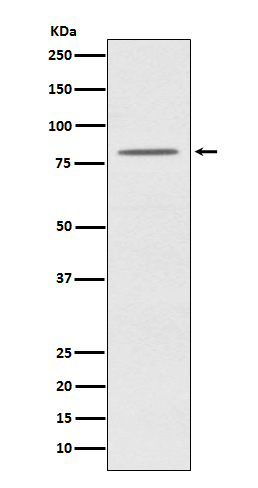
| WB | 1/1000-1/2000 | Human,Mouse,Rat |
| IF | 1/50-1/200 | Human,Mouse,Rat |
| IHC | IHC:1/100-1/200;IHF:1/50-1/200 | Human,Mouse,Rat |
| ICC | 1/50-1/200 | Human,Mouse,Rat |
| FCM | 1/20-1/100 | Human,Mouse,Rat |
| Elisa | 咨询技术 | Human,Mouse,Rat |
| Aliases | Large GTP binding protein; largeG; MGM1; Mitochondrial dynamin like GTPase; NPG; NTG; OAK; OPA 1;;OPA1 |
| WB Predicted band size | Calculated MW: 112 kDa ; Observed MW: 85 kDa |
| Host/Isotype | Rabbit IgG |
| Antibody Type | Primary antibody |
| Storage | Store at 4°C short term. Aliquot and store at -20°C long term. Avoid freeze/thaw cycles. |
| Species Reactivity | Human,Mouse,Rat |
| Immunogen | A synthesized peptide derived from human OPA1 |
| Formulation | Purified antibody in PBS with 0.05% sodium azide,0.05% BSA and 50% glycerol. |
+ +
以下是关于OPA1抗体的3篇参考文献及其简要摘要:
1. **"OPA1 requires mitofusin 1 to promote mitochondrial fusion"**
*Cipolat, S., et al. (2004)*
该研究利用针对OPA1的抗体进行Western blot分析,揭示了OPA1蛋白在不同亚型(长链和短链)的表达模式,并证明其与线粒体融合蛋白Mitofusin 1的功能协同作用,维持线粒体形态完整性和细胞凋亡调控。
2. **"Mitochondrial dynamics and inherited optic nerve diseases"**
*Alavi, M.V., et al. (2014)*
通过OPA1特异性抗体进行免疫荧光染色,研究者发现OPA1突变导致线粒体网络碎片化,影响视网膜神经节细胞的能量代谢,从而阐明其在遗传性视神经萎缩(ADOA)中的病理机制。
3. **"Proteolytic processing of OPA1 links mitochondrial dysfunction to alterations in mitochondrial morphology"**
*Frezza, C., et al. (2006)*
该研究使用OPA1抗体检测其在细胞应激条件下的裂解过程,发现OPA1蛋白的切割形式(S-OPA1)减少会导致线粒体嵴结构破坏和细胞色素c释放,最终触发细胞凋亡。
4. **"Mitochondrial OPA1. apoptosis, and heart failure"**
*Chen, L., et al. (2012)*
利用OPA1抗体进行组织免疫组化分析,发现心力衰竭模型中OPA1表达水平下降与心肌细胞线粒体断裂及功能障碍密切相关,提示其作为潜在治疗靶点。
**Background of OPA1 Antibody**
The OPA1 (Optic Atrophy 1) antibody is a crucial tool for studying the OPA1 protein, encoded by the *OPA1* gene, which plays a central role in mitochondrial dynamics and function. OPA1 is a dynamin-related GTPase essential for mitochondrial inner membrane fusion, cristae structure maintenance, and apoptosis regulation. Mutations in *OPA1* are linked to autosomal dominant optic atrophy (ADOA), a neurodegenerative disorder characterized by vision loss, and are associated with broader mitochondrial syndromes affecting the nervous system, muscles, and metabolism.
OPA1 antibodies are widely used in research to investigate mitochondrial morphology, bioenergetics, and quality control mechanisms. They enable the detection of OPA1 isoforms (long and short forms) via Western blotting, immunofluorescence, or immunohistochemistry, aiding in studies on mitochondrial fragmentation, oxidative stress, and cell death pathways. These antibodies also help explore OPA1’s interactions with proteins like MIC60 or prohibitin, which regulate cristae organization.
Additionally, OPA1 antibodies contribute to understanding disease mechanisms, therapeutic targets, and biomarkers in conditions like neurodegeneration, cancer, and metabolic disorders. Their specificity and reliability are critical for validating OPA1 expression patterns in cellular and animal models, advancing insights into mitochondrial dysfunction and potential interventions.
×